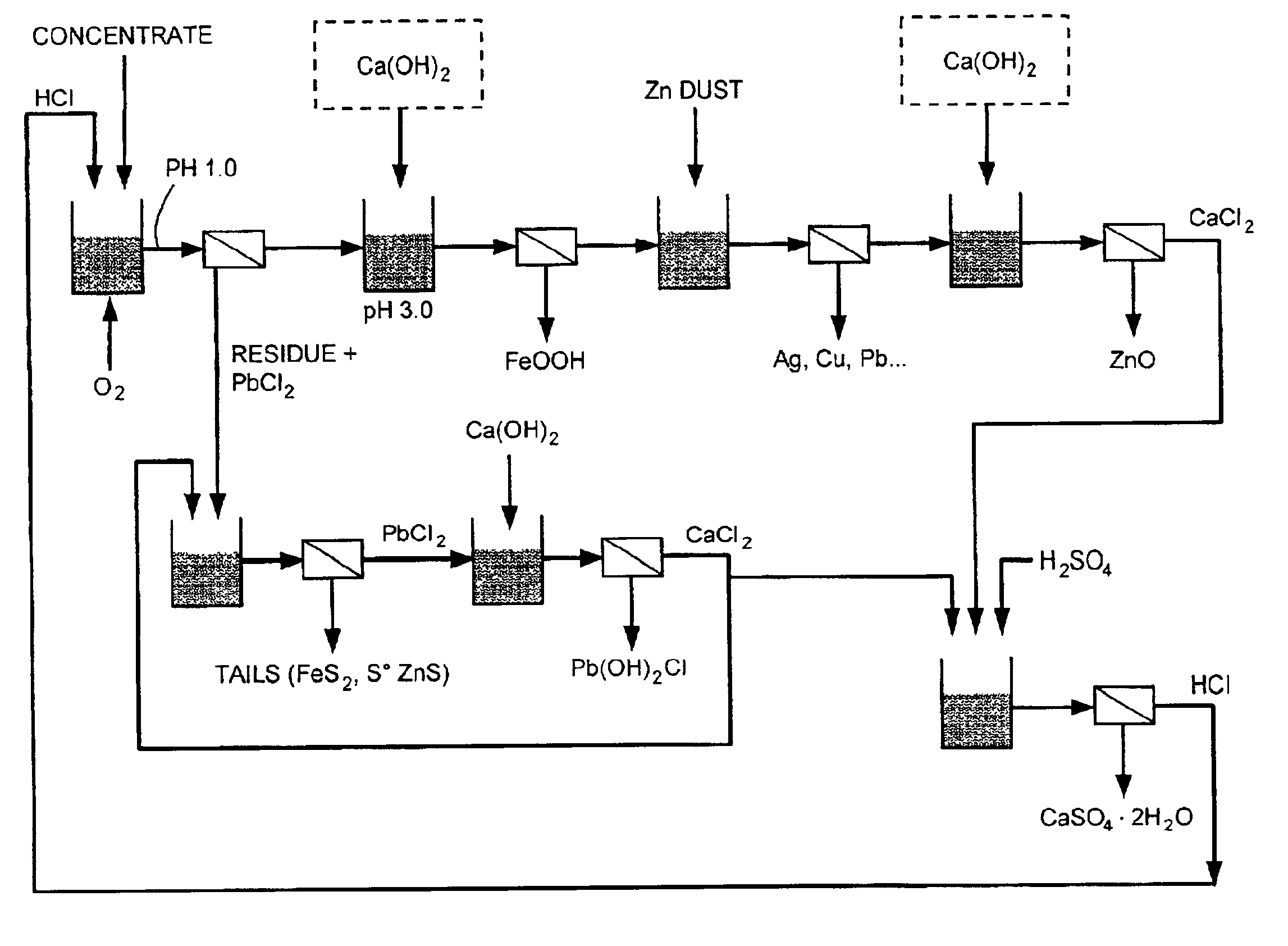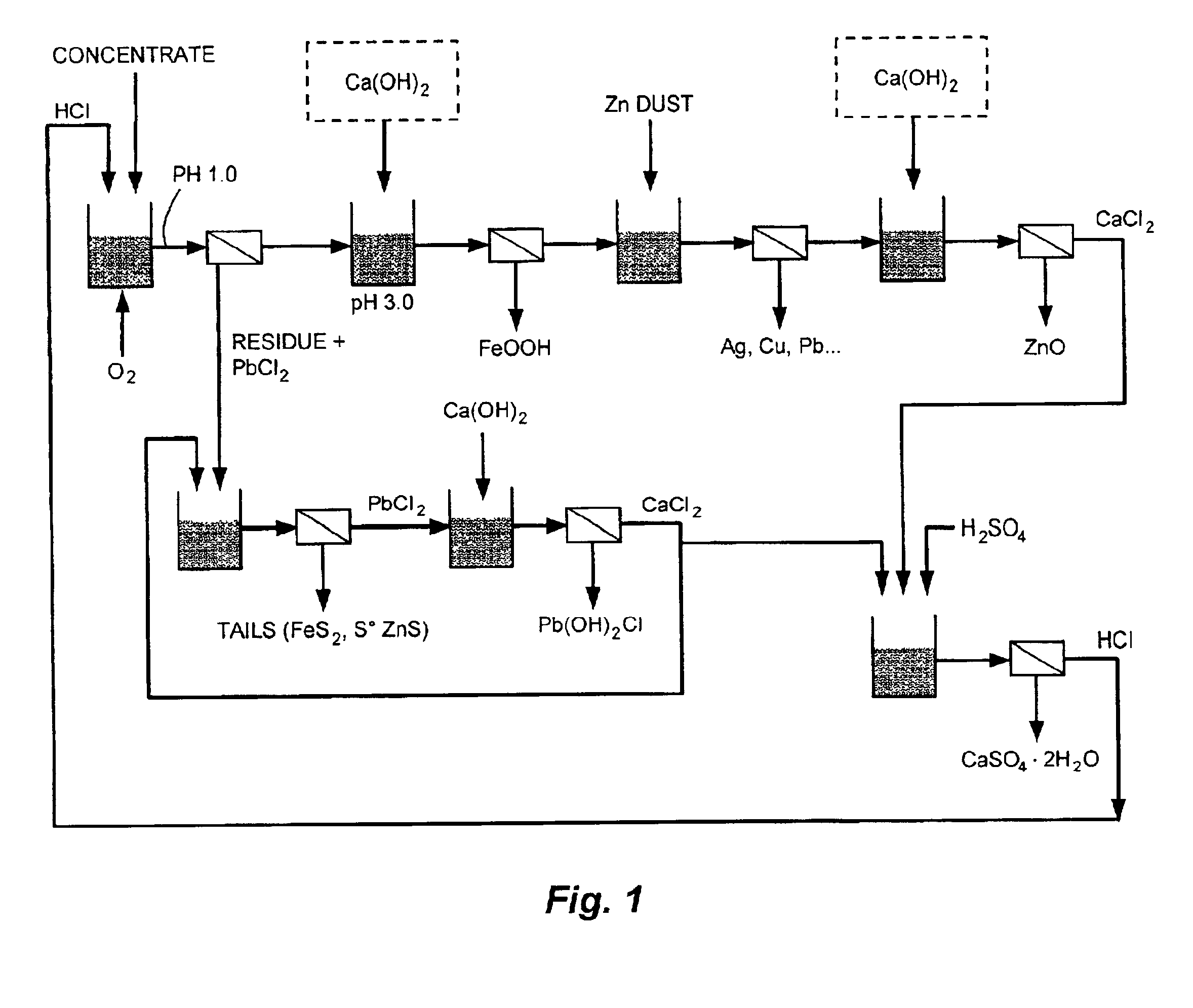Reduction of zinc oxide from complex sulfide concentrates using chloride processing
a technology of complex sulfide concentrate and reduction of zinc oxide, which is applied in the direction of mercury compounds, dissolving, separation processes, etc., can solve the problems of high cost of electrowinning zinc in chloride media compared to conventional sulfate electrowinning, increase in the shortage of conventional zinc concentrates, and increase in the cost of electrowinning zinc in chloride media. , to achieve the effect of reducing the chloride content of the produ
- Summary
- Abstract
- Description
- Claims
- Application Information
AI Technical Summary
Benefits of technology
Problems solved by technology
Method used
Image
Examples
example 1
Tests were conducted at 95° C., 3 N HCl and 400 mV (versus Ag / AgCl) with a 150% HCl stoichiometry based on Zn, Pb, and Cu content, oxygen as oxidant, and 7 hour retention time. The lead and zinc content was varied in different proportions to simulate the behavior of various complex sulfide ores. Under those conditions, zinc was extracted at 95%-99%, lead was extracted at 98%-99%, silver was extracted at 80%-89%, and iron was extracted at 10%-18%. The results are shown in Table 1.
TABLE 1Extraction of metals from complex sulfide ore by HCl / FeCl3 / O2 leachConcentrateCompositionMetal ExtractionPbZnZnPbAgFe%%%%%%6.614.6999980106.924.99798881513.615.69799801014.125.89599891811.320.596998611
example 2
Three tests were conducted at pH 3.0, 3.5, and 4.0, in order to evaluate the efficiency of Ca(OH)2 addition at different pH levels and the resulting quality of the purified solution produced. Iron precipitation takes place at 90° C.-95° C., a potential of about 300 mV(versus Ag / AgCl) without any ORP control, with oxygen addition for a duration of 120 minutes. The iron precipitate formed is an easily-filtered akaganeite (i.e., FeO(OH, Cl)). The results show that pH 3.0 is optimum for efficient iron precipitation, where zinc losses were 0.93%. (See Table 2 and Table 3). The iron neutralization can be carried out with zinc oxide ore. A zinc oxide containing 30% zinc was used to carry out the iron precipitation step at pH 3.0, with all other conditions remaining the same. The zinc extraction from the oxide ore was 90% where Fe concentration was lowered to approximately 0.32 mg / l. Therefore, a zinc oxide ore may be used to carry out this neutralization.
TABLE 2Analysis of solids after iro...
example 3
Cementation was conducted at pH 2.7, with agitation at a speed of 650 rpm, and a constant temperature of 90° C. The stoichiometric quantity of Zn added was based on the Cu, Pb, Cd, Ag and Co concentrations measured in the starting solution. The results shown in Table 4 indicate that Ag, Cu, and half of the Pb were removed with the Zn in an amount equivalent to 100% stoichiometry. At a stoichiometry of 200%, Pb, Cd, and some Co were removed, whereas at 300% most of the Co was also removed. Adjusting the zinc dosage leads to a cementation cake containing from 5% to 90% Ag.
TABLE 4Metal Concentrations in the Cementation Feed Solution and in Filtrateafter CementationStoich.AgCuPbCdNiTlCoHEAD40180014001308.41014100%<1.00.467451076.13.513200%<1.00.24<1.00.26<0.20<1.04.2300%<1.0<0.10<1.0<0.10<0.20<1.01.0Units (mg / l)
PUM
| Property | Measurement | Unit |
|---|---|---|
| temperature | aaaaa | aaaaa |
| pH | aaaaa | aaaaa |
| weight | aaaaa | aaaaa |
Abstract
Description
Claims
Application Information
 Login to View More
Login to View More - R&D
- Intellectual Property
- Life Sciences
- Materials
- Tech Scout
- Unparalleled Data Quality
- Higher Quality Content
- 60% Fewer Hallucinations
Browse by: Latest US Patents, China's latest patents, Technical Efficacy Thesaurus, Application Domain, Technology Topic, Popular Technical Reports.
© 2025 PatSnap. All rights reserved.Legal|Privacy policy|Modern Slavery Act Transparency Statement|Sitemap|About US| Contact US: help@patsnap.com



